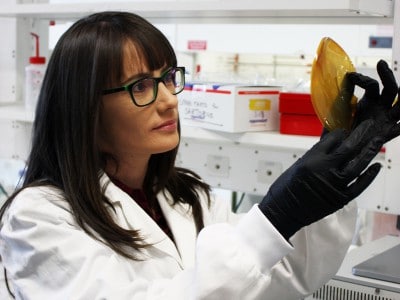

Scientists with the Commonwealth Scientific and Industrial Research Organisation (CSIRO) and Hanyang University in Korea have developed a method of regulating water retention in polymeric membranes, which could have significant impact on making fuel cells smaller and more efficient.
In solving the problem of size that thermal and water systems add to fuel-cell systems, the scientists drew inspiration from nature, noticing the way a cactus keeps itself regulated for water and heat in extreme conditions.
“A cactus plant has tiny cracks, called stomatal pores, which open at night when it is cool and humid, and close during the day when the conditions are hot and arid. This helps it retain water,” said CSIRO researcher and co-author Dr. Cara Doherty. “This membrane works in a similar way. Water is generated by an electrochemical reaction, which is then regulated through nano-cracks within the skin. The cracks widen when exposed to humidifying conditions, and close up when it is drier.”
According to Dr. Doherty, this new research asserts that a fuel cell can be made up to more than four times more efficient in hot and dry conditions, remaining hydrated without the need for external humidifier equipment bulking out its form.
The multi-continent research research project, 10 years in the making and published in the journal Nature, demonstrates how a membrane using what the team calls “nano-cracks”, or tiny fissures in a hydrocarbon polymer membrane that retards water desorption and maintains ion conductivity, should mean improved performance while shrinking fuel cell bulk.
“Fuel cells, like the ones used in electric vehicles, generate energy by mixing together simple gases, like hydrogen and oxygen. However, in order to maintain performance, proton exchange membrane fuel cells – or PEMFCs – need to stay constantly hydrated,” said co-author Dr. Aaron Thornton. “At the moment this is achieved by placing the cells alongside a radiator, water reservoir and a humidifier. The downside is that when used in a vehicle, these occupy a large amount of space and consume significant power.”
The research could have significant impact in Canada, which is a world leader in fuel cells, being home to both Ballard Power Systems (NASDAQ:BLDP) (TSX:BLD) and Hydrogenics Corporation (NASDAQ:HYGS) (TSX:HYG).
_________________________________________________________________________________________________________________________________________________________________________________________________________________________________________________
Interested in Electric Vehicles?

This article is brought to you by Nano One (TSXV:NNO). Nano One is changing how nanomaterials are made for batteries and other billion dollar markets. Click here to learn more.
____________________________________________________________________________________________________________________________
Not to mention the fact that the fuel cell industry needs a shot in the arm as it appears to be losing competitive advantage to batteries in the electric vehicle arms race, with the success of companies like Tesla and various levels of government supporting the installation of street-side and roadway electric car charging stations.
In February 2015, Ballard announced an $80 million U.S. Technology Solutions transaction with Volkswagen for the transfer of the company’s automotive-related fuel cell intellectual property (IP) and a two-year extension on an engineering services contract.
And three years ago, a group consisting of Ford, Renault-Nissan and Daimler, with help from Ballard, announced plans to launch “the world’s first affordable, mass-market fuel cell car” by 2017, jointly developing a fuel cell system to and advance the availability of zero-emission vehicles.
Leaders in the fuel cell space will obviously be watching this new scientific development with interest, as it may impact technologies developed by at least two world-class Canadian companies.
“At the moment, one of the main barriers to the uptake of fuel cell electric vehicles is water management and heat management in fuel cell systems. This research addresses this hurdle, bringing us a step closer to fuel cell electric vehicles being more widely available,” said research leader Professor Young Moo Lee from Hanyang University. “This technique could also be applied to other existing technologies that require hydrated membranes, including devices for water treatment and gas separation.”
Leave a Reply
You must be logged in to post a comment.


 Share
Share Tweet
Tweet Share
Share




Comment